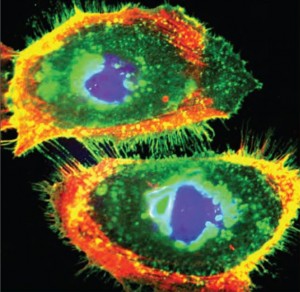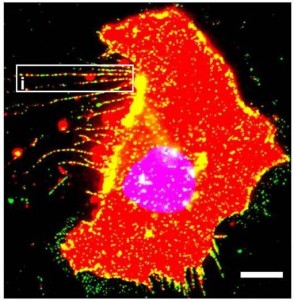Thank you to Roger Dickerman and Relentless Fitness for hosting our talks last weekend. Shou-Ching and I had a great time. If you work or live in Philadelphia and would like a personal trainer, they are the place to go.
Aaron Olson’s PaleoRunner Podcast
Aaron Olson is a runner and Paleo dieter and I had the privilege of being the first guest of his new “PaleoRunner” podcast. (Tim Noakes will be the second, so I’m in great company.)
The interview is up on the website http://paleorunner.podbean.com/. Aaron is publishing his podcasts with linked enhanced content; this enhanced content is only available on Apple devices. To view the enhanced content, manually add Aaron’s feed to iTunes: http://paleorunner.podbean.com/feed/. As the file plays, click on images for chapters and extra content.
Shou-Ching’s Pretty Pictures
We haven’t blogged about Shou-Ching’s research, but since she’s pictured today on the front page of the Beth Israel Deaconess Medical Center website (see the story “Innovation is in the DNA of our Institution”), I thought I’d show two of her pictures that are publicly available on the web.
BIDMC’s Technology Ventures Office featured a picture from Shou-Ching’s research in a recent report. Here it is:
This is an image of two endothelial cells interacting in cell culture. Endothelial cells are the cells that line the walls of blood vessels. You can see that endothelial cells interact via long thin structures that Shou-Ching and her colleagues have dubbed ‘nanopodia.’
The paper in which they introduced the term ‘nanopodia’ [1] appeared in 2011 in the journal Angiogenesis. One of Shou-Ching’s images was chosen for the journal cover. Here is the image:
In this image green is a marker of nanopodia, red marks the cell boundaries, and blue marks the nucleus (seen as the pink blob in the center). The white bar shows a length of 10 μm.
The nanopodia on the left are on the trailing rear of this moving cell, and the nanopodia on the lower right are on the leading front. Nanopodia, Shou-Ching and her colleagues have found, are essential for endothelial cell movement.
Endothelial cell movement and interactions are important in vascular and cancer biology, so these structures are quite important! If you’d like to read more, the Angiogenesis paper is open access.
References
[1] Zukauskas A, Merley A, Li D, Ang LH, Sciuto TE, Salman S, Dvorak AM, Dvorak HF, Jaminet SC. TM4SF1: a tetraspanin-like protein necessary for nanopodia formation and endothelial cell migration. Angiogenesis. 2011 Sep;14(3):345-54. http://pmid.us/21626280.













Congratulations to Shou-Ching the cover girl.
I remember seeing a pictorial in Omni magazine way back when I was a kid about the art of staining cells and such for insight into their workings. Obviously the technology has come a long way since then but I imagine it’s still quite an art.
Technology has come a long way. They now have fluorescent proteins of various colors that you can bond to the antibody of your choosing; these antibody-fluorophores bind to the proteins you want to study and label them with different colors. There are various proteins which label specific cellular compartments, like nucleus, mitochondria, late endosomes, membrane, etc, so you can tell where your things are relative to subcellular structures and to other proteins.
It’s a good field for artists!
Congratulations Shou-Ching!
Great pictures and a timely reminder that the single-celled animals we evolved from were very interactive with their environments and each other.
Yes … and human cells are even more interactive!
Brilliant pictures Shou-Ching!
Paul, any info about the release date of your PHD cookbook that you talk about in many the podcasts?
Keep on the good work.
Hi Peter,
Our intention is to complete a first draft this summer and see where we stand. I don’t know how many drafts we’ll want to do or how long it will take to choose a publication method. If we go the electronic-only route (iPad/tablet) it can be published very quickly, color printed books take a lot longer.
One vote for a color printed cookbook with lots of pictures. 😀
Thanks for the info Paul!
I can’t wait and yes, printed is the way to go. 😉
Those pics are brilliant! They make great modern art that would good for my wall!
There should be a ‘be’in there somewhere!
cool!
FTR: the podcast link is broken.
Funny, it works for me.
Paul,
I am doing the IF for about a week now (16h/8h). I don’t have any problems with any food cravings during the fast since I am very fat adapted. I break the fast with only veggies, meats and healthy fats because I want to extend the fat burning status. After that I get another PALEO meal (3h after 1st meal but again without PHD safe starches) and I have weight training before the last (third) meal where I finally have a bigger portion of safe starches.
In the mornings I have an organic green tea with ghee, MCT and coconut oil but I get constant cold in the last 4-5h of fasting (while working in the office). Mood is ok, but the chills are making me worry. In addition I’ve read that fasting is not good for hormonal balance and production of testosterone. There was a study but at the moment I cannot find the link.
Should I be worried about my hormonal balance and constant colds? I guess it would be better to have some safe starches in every meal as pointed out in the book.
What are your thoughts?
Thanks,
Peter
Hi Peter,
First, as long as you restrict carbs to 30%, you will be fat burning all day. Restricting carbs further doesn’t shift any cells away from glucose burning, all the cells that can are already 100% fat burning except during intense athletic efforts. Rather, further carb restriction starts depriving the body of essential nutrients. That can lead to adrenal stress, downregulation of thyroid hormone levels, and issues like the ones you are experiencing.
So I would eat starches at every meal, and keep them to 30% of energy.
Thank your VERY much!
Everything gets SO logic when you explain it.
“…as long as you restrict carbs to 30%, you will be fat burning all day. Restricting carbs further doesn’t shift any cells away from glucose burning, all the cells that can are already 100% fat burning except during intense athletic effort”
Paul, I’m curious what evidence you see supporting this assertion. Is it based on a theoretical calculation, or is there direct empirical evidence for it?
If this is so, how is it that many people (including Jimmy Moore) only lose their fat when they drop carbs way below 30%, sometimes only when they drop them far enough to enter nutritional ketosis?
Hi Bill,
It’s a combination. The gold-standard empirical evidence would be tracking the destinations of isotopically labeled glucose in people on low-carb vs high-carb diets. Not sure if that’s been done. But we have plenty of empirical evidence, eg triglycerides are low at 30% carb diets, around 50 mg/dl, and stay there at all lower carb intakes. Triglyceride levels are controlled by fat uptake, if you’re fat burning you generally have low triglycerides.
Obesity is a more complex phenomenon than just fat burning vs carb burning. There are plenty of people who lose weight better on 30% carb than on 0% carb. Jimmy might be one of them, but he doesn’t dare try it.
I always though you burned fat 2-4 hours after any meal, when your insulin is low enough. I guess that’s if you don’t have extra glucose to get rid of.
“… as long as you restrict carbs to 30%, you will be fat burning all day. Restricting carbs further doesn’t shift any cells away from glucose burning, all the cells that can are already 100% fat burning except during intense athletic efforts. Rather, further carb restriction starts depriving the body of essential nutrients. That can lead to adrenal stress, downregulation of thyroid hormone levels, and issues like the ones you are experiencing.”
I am very (very) far from any expert in any of this,
But if the above statement is correct/true, (& i have no reason to doubt it) then this statement would be something i can easily get my head around.
It would sum up everything to me relating to optimum carb intake, in one clear & concise paragraph.
…please let it be true 🙂